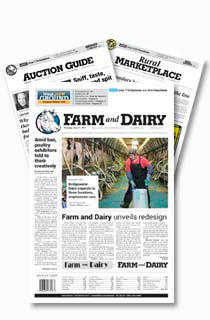LEXINGTON, Ky. – Cattle producers try their best to monitor the health of their herds for any sign of sickness and disease. For large producers, that can be a time-consuming task.
But new research at the University of Kentucky College of Agriculture could give farmers a real-time, inexpensive way of spotting signs of illness earlier, thus making treatment quicker and more effective.
With a grant of nearly $900,000 from the U.S. Department of Homeland Security, beef cattle nutritionist Eric Vanzant and Craig Carter, epidemiologist for the university’s Livestock Disease Diagnostic Center, are collaborating on a project that also includes Eastern Kentucky University and NetQuest, a corporate partner based in Louisville.
Ear sensor. Vanzant is placing a monitoring device, designed as part of an ear tag by NetQuest, in the ears of some cattle at the UK Animal Research Center in Woodford County.
The device will transmit real-time, ear-surface temperature data, as well as head position of cattle, via antennae to a receiving station.
Vanzant and other researchers will then be able to immediately analyze the data and respond to early signs of sickness within the herd.
“Our real motivation behind this was to come up with devices, not necessarily from a national biosecurity standpoint but from a standpoint of individual producers, and give them a tool that they can use to detect sick animals in the herd,” Vanzant said.
Measures activity. So they worked on an ear tag that contains sensors to give information about the animal.
“Right now, we’re focusing on some very noninvasive types of sensing. We’re measuring the temperature of the ear, where the ear tag is located. We’re measuring activity of the animal.
“The main activity we’re able to pick up is eating and drinking behavior. This will allow us to detect when animals are off feed, which is the first sign of illness.”
Disease control. From the biosecurity standpoint, Vanzant said the research could play an important role in identifying possible disease outbreaks early on, so folks like Craig Carter can issue alerts to producers about what may be coming down the pike, ultimately based on data gathered from herds around the state.
“The information we look at is mostly from cases that have been given to us by practicing veterinarians around the state, and so currently, the disease monitoring that we can do is pretty limited to findings that we make in laboratory testing,” Carter said.
That’s everything from a whole animal necropsy all the way down to one blood test that might be an indicator of a disease process that’s going on in the state.
The project has let them build computer systems to better gather some of that information, analyze it and generate alerts in case of a disease outbreak.
“At the laboratory we’d be more apt to generate that on a regional or county level when we see an increased incidence of something that’s going on, and then mount a response,” Carter said.
Going ‘live.’ Up to this point, Vanzant said, the work has been done inside in a controlled situation – with “pretty pampered animals.”
“We’re just at the point right now to be getting sufficient numbers of tags to start doing some of the field work that really has to be done to adequately test feasibility and implementation of this,” he said.
“We’ve got plans in place to test it on farms in Kentucky – to track animals in transit from Kentucky to feedlots in the high plains, and then to continue tracking them through that process.”
Leading edge. Carter said that Vanzant is one of very few animal scientists in the country on the leading edge of this type of technology.
“It’s really going to change the way farms look at animal health,” he said.
“We are on the cusp of this wireless society and a whole brave new world is going to open up so many new applications and increase the capacity of our ability to monitor animal health in a near real-time, or even in a real-time fashion.”
What’s next? Vanzant said additional research could be explored in the future, including measuring pulse rate, blood oxygen level and even the cow’s location on the farm
Get 4 Weeks of Farm and Dairy Home Delivered









